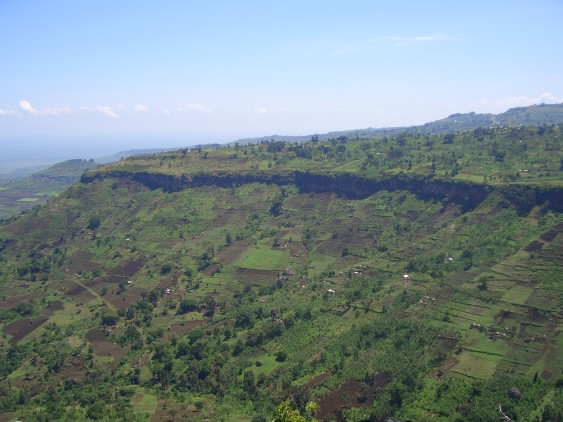Why do people live near volcanoes?
At first it may seem odd that people would want to live close to a volcano. After all, volcanoes have a nasty habit of exploding, discharging liquid rock, ash, poisonous gasses, red hot clouds of embers, and generally doing things that kill people. Yet, throughout history, people have deliberately chosen to risk all those hazards and live near them, even on the slopes of active volcanoes that have erupted within living memory.
They chose to live close to volcanoes because they felt that the advantages outweighed the disadvantages. Most volcanoes are perfectly safe for long periods in between eruptions, and those that do erupt more frequently are usually thought of, by the people who live there, as being predictable.
Today, about 500 million people live on or close to volcanoes. We even have major cities close to active volcanoes. Popocatapetl (pronounced poh-poh-kah-teh-peh-til) is a volcanic mountain less than 50 miles from Mexico City in Mexico.
In short, the main things that attract people to live near active volcanoes are minerals, geothermal energy, fertile soils and tourism.
Lets look at each one...
Minerals
Magna rising from deep inside the earth contains a range of minerals. As the rock cools, minerals are precipitated out and, due to processes like the movement of superheated water and gasses through the rock, different minerals are precipitated at different locations. This means that minerals such as tin, silver, gold, copper and even diamonds can be found in volcanic rocks. Most of the metallic minerals mined around the world, particularly copper, gold, silver, lead and zinc are associated with rocks found deep below extinct volcanoes. This makes the areas ideal for both large scale commercial mining and smaller scale local activities by individuals and small groups of locals. Active and dormant volcanoes have the same mineralisation, so like extinct volcanoes, they are rich sources of minerals.Hot gasses escaping through vents also bring minerals to the surface, notably sulphur, which collects around the vents as it condenses and solidifies. Locals collect the sulphur and sell it.
Geothermal Energy
Geothermal energy means heat energy from the earth. It's unusual to use the heat directly, by building your house on top of a steam vent for example, because it's unpredictable, dangerous and messy.
The heat from underground steam is used to drive turbines and produce electricity, or to heat water supplies that are then used to provide household heating and hot water. Where steam doesn't naturally occur it is possible to drill several deep holes into very hot rocks, pump cool water down one hole and extract steam from another hole close by.
The steam isn't used directly because it contains too many dissolved minerals that could precipitate out and clog pipes, corrode metal components and possibly poison the water supply.
Countries such as Iceland make extensive use of geothermal power, with approximately two thirds of Iceland's electricity coming from steam powered turbines. New Zealand and to a lesser extent, Japan, also make effective use of geothermal energy.
Fertile Soils
Volcanic rocks are rich in minerals, but when the rocks are fresh the minerals are not available to plants. The rocks need thousands of years to become weathered and broken down before they form rich soils. When they do become soils though, they form some of the richest ones on the planet. Places such as the African Rift Valley, Mt Elgon in Uganda, and the slopes of Vesuvius in Italy all have productive soils thanks to the breaking down of volcanic rocks and ash. The Naples area, which includes Mount Vesuvius, has such rich soils thanks to two large eruptions 35,000 and 12000 years ago. Both eruptions produced very thick deposits of ash and broken rocks which have weathered to rich soils. Today, the area is intensively cultivated and produces grapes,vegetables, orange and lemon trees, herbs, flowers and has become a major tomato growing region.
Tourism
Volcanoes attract millions of visitors every year, for different reasons. As an example of the wilder side of nature, there are few things that can beat seeing an erupting volcano blowing red hot ash and rock thousands of feet into the air. Even the less active ones that are just puffing out steam and smoke are impressive sights and attract tourists from around the world.
Around the volcano may be warm bathing lakes, hot springs, bubbling mud pools and steam vents. Geysers are always popular tourist attractions, such as Old Faithful in the Yellowstone National Park, USA. Old Faithful is such a popular tourist feature that it even has its own 24 hour Old Faithful webcam.
Iceland markets itself as a land of fire and ice, attracting tourists with a mix of volcanoes and glaciers, often both in the same place. The wild, raw and barren volcanic landscapes also attract tourists who want to see what the early planet may have looked like.
Tourism creates jobs in shops, restaurants,hotels and tourist centres / national parks. Locals economies can profit from volcanism throughout the year, whereas skiing, for example, has only a limited winter season.
In Uganda, a country trying hard to increase its tourist industry, the volcanic region around Mt Elgon is being heavily promoted for it's landscape,huge waterfalls, wildlife, climbing and hiking and its remote 'get away from it all' location.
![]()
